I’ve been meaning to write a review of the Klim Badlands Pro Suit for a while and now that I’ve found the time to do so I realise a review of the jacket/pants is not enough. Sure I could just tell you how great it is but at the end of the day writing a review dedicated to the Klim Badlands Pro is a bit of a missed opportunity that will inevitably mean feck all once the Badland Pro goes through aninevitable update.
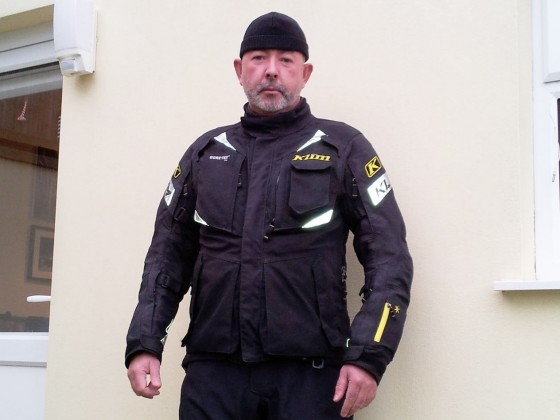
All wrapped up for winter ![]()
If you’re reading this you’re most likely interested because you’re in the market for a new touring jacket and/or pants but lets cut straight to the chase, this jacket is not only expensive but lives in a market swamped by strong opposition. Or is it? In the modern world of motorbike touring gear you’re in for a right thumping headache making a choice unless you choose your gear by blind brand loyalty. If like me you have no particular brand loyalty and need a protective, comfortable, long lasting, functional suit and value for money the choosing process is becoming immensely complicated due to the sheer amount of choice available. Not to mention the brand marketing departments in full swing selling the idea of adventure and what gear you need to achieve it.
My touring season of 2013 saw me and many others riding through some shocking and unseasonable weather, from freezing temperatures and hail on Ireland’s west coast in April, snow in the Pyrenees in early May through to torrential downpours lasting days compounded with rapidly melting snow in late May and early June. All this saw to a very wet end of more than just my SatNav and camera gear.
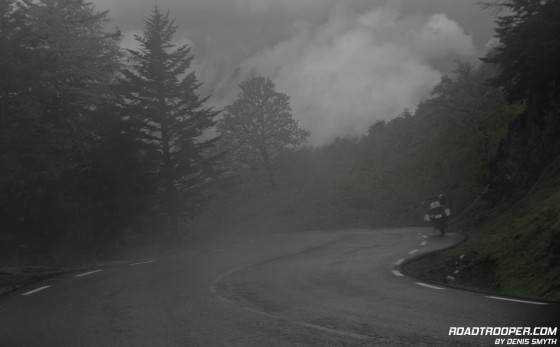
Freezing tempertures and heavy rain near Col de Pierre St Martin, late May 2013
Boots, helmet, jacket, pants, gloves all showed signs of imminent failure. All my gear was originally good quality and I spent many happy hours maintaining it all, but after 6 years, countless miles and the bonkers weather of 2013 I was facing the truth – I’d got my moneys worth from my gear and it was time to put my hand in my pocket to start replacing it. And so began my journey into the confusing world of todays motorbike touring gear.
The winter of 2014 saw me spending hours, days, nights sifting through endless options for a touring suit, reading countless review sites before crawling over to YouTube Channels like Revzilla to try and get a better understanding of the options for jackets etc. Rev’it, Dainese, BMW, Alpinestars, AGV, Ruka, Belstaff, Furygan, Held, Klim, Icon, Ixon, IXS, Scott, Sidi, Spyke and 10 others were all firing endless options at me. So much so that I felt like kicking the shite out of a bag of spuds in frustration. A clear case of analysis paralysis and information overload!
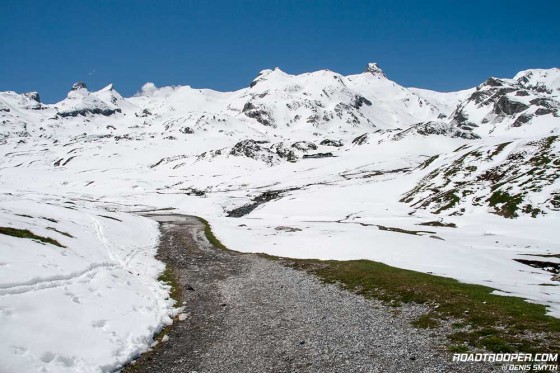
Near the French/Spanish border, Col de Pourtalet May 2013
My requirements for my next touring suit were the following:
- It had to suit a northern winter of -5C and +10C with plenty of wind and rain and a Spanish summer of about +20C to +40C
- Spring and Autumn in the Alps and Pyrenees where anything goes, especially the Pyrenees where in May it can be +20C and above with pissing rain or +5C with torrential rain or sleet.
- Comfortable for long hot days on the motorway and cool/ventilated for swelteringly hot days on Pyrenean forest mountain tracks or the dirt trails in southern Spain.
- Excellent armoor, I’m a novice off-road rider so falls are to be expected.
- Hassle free, quick, no fuss ease of use in all weather conditions so I would not need to pull over to get my boots, pants and jacket off to install an inner waterproof layer every time the weather turned foul.
Now, back to the review, due to my frustration induced spud sack kicking tendencies this review will not just be about the Klim Badlands Pro but will equally be about why I chose it above the rest and also hopefully explain the key points to consider before you even start looking for a new touring suit. Take note, I am in way going to tell you the Klim Badlands Pro is the best on the market, while I have chosen it as the best “for me” it may or may not necessarily suit you! Read on and lets see how I came about my final choice.
BMW Rallye 3
I’ve clocked up a fair few miles over the last 6 years since I last updated my riding jacket to the BMW Rallye 3. The Rallye 3 jacket quickly became my go to gear both for touring and everyday use as quite frankly it is brilliant kit. At the time of purchase it cost me a ball clenching €550 for the jacket alone and it took some serious convincing for my wife to see the reason for the expense and I have to admit I was worried at the time that the investment would be worth it.
My reasoning for choosing such an expensive jacket was twofold. Firstly the cheaper gear I was usually buying never lasted very long and I ended up replacing such average fair within 2 years. Secondly was for it’s heavily fortified protection which takes a little more explanation. Like many riders in the beginning of their biking life it was all about the bike and my budget for personal protection was barely an after thought. Age, experience and with a few friends and peers in the grave I was starting to re-prioritise what I invested in. On top of that, at the time I’d just bought a BMW F650GS and I wanted to digress my biking experiences off the usual paved roads I’d so far been riding and onto forest trails and thereby increasing my chances of a off, so it was time to get decent protection.
More importantly the Rallye 3 jacket has one fault specific to this jacket – the stupid ass waterproof pockets! While the pockets themselves have a waterproof liner the velcroed flap covering them does not so in persistent rain the pockets fill up with water. That’s great if you want to bring your goldfish out for a spin, but it’s a right pain in the arse when I’d find my pack of smokes and cash had dissolved as I unloaded a flood of water onto the floor of a road side cafe.
I’ve also found that after 6 years of riding in all seasons the inner removable waterproof liner set-up does not suit me, in fact it’s another complete pain in the arse. I’ve spent countless wasted hours over the years pulling over to put on or remove the blasted liner every time the weather changes. Anyone who’s faced and Irish summer (all four seasons in a day) or toured in the French Pyrenees in early summer will know what I’m on about. In warm wet weather I’d get wet without the liner or sweat soaked with it. Due to the heat I’d not want to wear the inner waterproof layer as it’s not as breathable as you might think so in hot changeable weather I’d end up pulling over 3 or 4 times a day to take it off/on.
I would have thought BMW would have solved some of these issues in the 5th version of the Rallye jacket, however in my research the only things that have been updated (that I could tell) is the armour (now more flexible in colder temps) and the color scheme. Now ignoring the fact that the outer shell / inner water proof system does not suit me it was now a definite sorry Mr. BMW, but I’ll be buggered by a rabid badger before I fork out €500 for a jacket that’s essentially unchanged since the Rallye 2 came out in 2004!
3 Approaches to designing a motorbike touring or adventure/touring jacket
Before I move on to the Klim Badlands Pro or anything else this might be a good time to explain the 3 essential and very different approaches to designing a motorbike touring or adv/touring jacket because this is where you really need to make the first big decision before ye even think about looking at what the big bands are offering. Please ignore the price tags on the following examples as I’m only putting these options in to explain the essentials of what you need to take into account before you figure out which approach suits your requirements best.
Like I said before, there are 3 main and differing solutions to the touring or adventure touring suit…
Solution 1
An armoured, highly ventilated (part mesh type) jacket/pants with a separate waterproof detachable outer jacket/pants, essentially a double combo, the Touratech Companero being a good example here. This can be really expensive and comparable with buying a good quality summer jacket/pants plus a set of heavy duty Gore Tex overalls for winter – both at the same time.
See example »
Solution 2
A protective jacket/pants armoured shell with a separate weather/waterproof detachable inner liner. This is the most common setup and typically comes with two inner liners, one thermal and one Gore Tex or similar. This system is generally very economical as each component is relatively easy to manufacture. Each component can also be made separately by the lowest bidder then assembled, branded, packed and shipped by a fourth player. The Rev’it Defender is a good example of this.
See example »
Solution 3
A Pro Shell three-layer laminate textile composite material jacket/pants consisting of tear, friction resistant outer material with a GORE-TEX breathable membrane sandwiched between the outer and a soft inner liner layer. These are just a “shell” and have no inner liners. The Klim Badlands Pro is a tri-laminate Pro Shell, a basic (armour supporting) inner liner with a Gore Tex Pro & Stretch Gore-Tex liner sandwiched between a Kevlar-Ripstop/Cordoba mix of materials. This is inherently expensive due to the time and complexity of production. At first this system may not seem like good value as you get no extras like a thermal layer. In the beginning the Badlands was actually on the bottom of my list because of this which was a bit stupid of me as I have amassed a fine collection of thermal layers over the years.
See example »
Example of solution 1
Touratech’s Companero Suit is everything you might need in a touring suit. It won’t be easy to ignore the price tag on this beauty, but it’s a rather unique approach and a serious suit.
The Companero Suit
Jacket £1100 Pants £650 (Are you f%cking serious????)
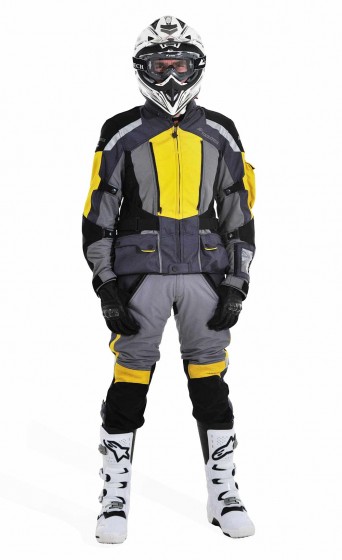
Get off the stage you clown, ye ‘ain’t foolin anyone in that outfit lad. Touratech’s marketing boy’s obviously don’t like to get their fancy gear dirty….
It’s expensive no doubt but once you have a closer look at it you see where your money is going. In this case and uniquely so, you get two jackets (1 winter, 1 summer) and two sets of pants with this set up. The first jacket/pants is your summer suit. This consists of a highly ventilated and comfortable synthetic fiber that’s state-of-the-art in terms of its tear and wear-resistance properties. The most vulnerable areas are reinforced with a layer of Cordura 2000 and is fully equipped with CE-approved protectors and some flashy reflective safety panels. It’s NOT in any way water resistant, think of it as a top shelf mesh-like jacket/pants perfect for cruising the Mediterranean in the summer months.
The second layer of the Touratech Companero can be used in colder weather or in the rain. Perfectly tailored to match the cut of the summer suit, you simply pull it on over the top and zip up the connectors. The Companero uses the Pro Shell three-layer laminate. In this textile composite material, the inner lining, the top-quality GORE-TEX breathable membrane and the tough outer layer are bonded into one fabric. This means the laminate is not too bulky, doesn’t bulge, and always fits nice and snugly. Of course the most important properties of the oversuit are that it is wind and waterproof. And since Pro Shell is an active material, the suit is fully breathable. (Eh, this is where I start to have a problem with this setup, but I’ll get back to this in a bit after the Touratech spiel).
Whats clever with the Touratech Companero is that the windproof, waterproof membrane forms the outer layer of the clothing system unlike the BMW Rallye 3 where the waterproof/windproof membrane is a removable inner. With the outer Companero jacket in place the airy summer suit now acts as an air cushion inside that functions as a thermal lining. An additional insulating layer such as fleece underwear is only needed in extremely cold weather. In real shitty wintry conditions the additional storm collar is also a nice touch. As you’d expect, the jacket and trousers of the membrane suit can also be zipped together. This is the Touratech marketing dept’s take on it anyway which to be fair is not far off the mark.
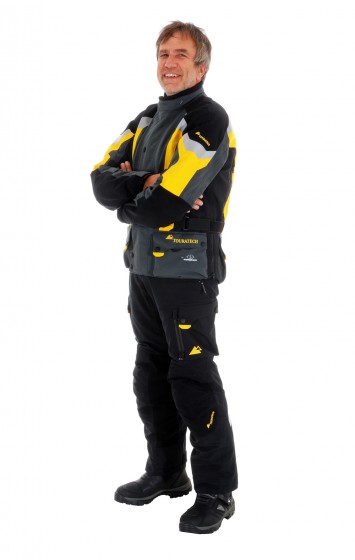
This is Herbert Schwarz, one of the main dudes behind Touratech. Love the Touratech gear, although much of it is well out of my price range.
In comparison the Companero’s water proof “layer” is a full blown textile bike jacket with a Gore Tex membrane, it does not fold up into a neat little lightweight ball at all. It will take up a very large space (4-5 litres) in your back box or pannier, more so if you include the outer pants, for me it’s simply not practical for summer touring as I like to travel very light using only 35ltr soft panniers. You do get a pouch to stuff the jacket or pants into which does then attach to the back of the jacket, but this will make you look a gigantic ass contestant. It will also interfere with your pillion it’s that big unless you have the real estate of an RT or Goldwing to play with. A pillion will also most likely find it impossible to attach the outer jacket to the back of the inner jacket if rear luggage or top box is fitted to the bike.
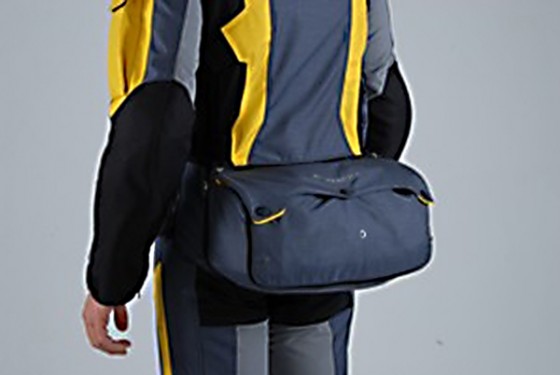
You’ve got to be kidding me, if I met my mates with this hanging out of my arse I’d never hear the end of it…
Another big downside is if you hit warm wet weather you’ll essentially end up wearing two jackets and two pants with the outer layers severely affecting airflow to your body. Remember, with the outer Companero jacket in place the airy summer suit now acts as an air cushion inside that functions as a thermal lining. So if it’s 22C and pissing rain in Italy or Spain you will have a choice of getting rain wet or stinky sweat wet, either way you’re getting very wet! Gore Tex is breathable to a point, but I think this ability is severely restricted in this setup under hot and wet conditions and probably far worse when riding energetically off road. I did not road test this jacket, but I cant help think it’s going to be far too hot for wet weather summer riding. And with the bulky nature of the outer jacket I’d only end up leaving it at home for much of the year and instead take my trusty Lidls waterproof jacket in case of rain. In this case I’d be far better off choosing the BMW Rallye 3 and also save £600 on the jacket. So for me the Touratech setup is a non runner. In short, the Companero does deep winter and high summer very well indeed, but everything else inbetween is questionable at best.
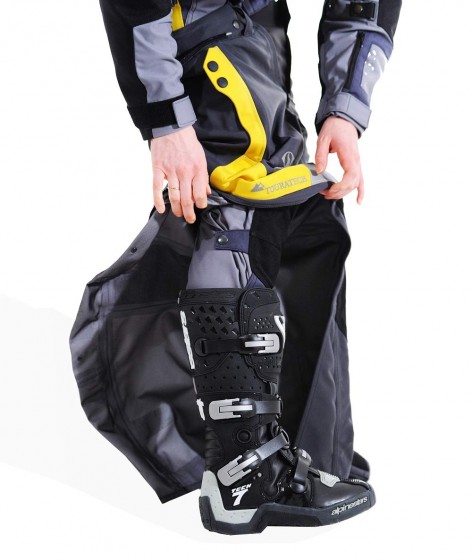
So tell me again, after shoveling out the guts of 2K why do I still have to stop and put on more gear when it rains?
The Companerio is a very well made, long term, all weather suit and I really liked it, but seriously for 2 fecken grand I don’t see why I should have to stop and starting putting on more gear every time it rains so bollox to that! This suit is strictly for the ridiculously rich, the mad and the sponsored. In fact the only positive reviews I found on this suit were heavily sponsored by Touratech, shame on you Charlie lol
Touratech do make a Gore Tex Shell jacket/pants – the Boreal, but at £1000 for the jacket alone I said no thanks as I saw nothing special about it to warrant that price tag.
A closer look – Touratech Companero…
Next on the list of options…
Solution 2
A protective jacket/pants armoured shell with a separate weather/waterproof detachable inner liner.
Again loads on offer in this category, but the two that really caught my eye were the Dainese D-Explorer suit and the Rev’it Defender. The Dainese D-Explorer comes in at roughly £500 for the jacket and £350 for the pants. This is another very impressive and well thought out all weather, all season suit and much lighter on the pocket comparing to Touratech’s offering.
A closer look – Dainese D-Explorer Jacket Review…
However I ruled it out for 2 reasons, firstly the removable under Gore Tex falafel and fuss which had come to annoy me. The 2nd and even bigger reason was that this suit is really a 100% road touring suit with not enough free movement (especially the pants) or armour for off road use.
A closer look – Dainese D-Explorer Pants Review…
The Rev’it Defender suit was a serious contender however - even considering the removable Gore Tex / thermal liner system. The Rev’it Defender has been a very popular suit world wide for good reason and costs £320 for the jacket and £260ish for the pants offering very good value. I already had the pants which I’d had to get on short notice for my 2013 biking season after I’d, eh, put on a bit of weight and could no longer fit in my regular touring pants.
A closer look – REV’IT Defender GTX Jacket & Pants Review…
Another downside is the waist cinching system for tightening the pants which kept coming loose, so when the outer shell got wet and heavy my elasticated heavy duty braces had great difficulty keeping the pants from heading south to my ankles. I also found the venting in really hot weather 30C and above good but not good enough due to a lack of rear vents. The venting was manageable if I were only facing a couple of weeks a year in hot weather, but not for the constant dead heat I face for months on end in the deserts of southern Spain. So, between the ill fitting armour in the pants, the down side of super fabric and my personal dislike of the inner water proof layer system I decided the Rev’it Defender was not right for me either.
The Ruka Airway jacket (£400) and matching Airvision pants (£310) had also caught my eye. Despite the confusing Airway/Airvision naming Ruka have a far better solution to summer touring in that the outer shell allows air to freely flow through without using mesh which by definition is weak and un-protective in a spill and also greatly aids dehydration. Typicle mesh jackets/pants are a poor choice for long touring days in hot weather and no one has yet to convince me otherwise. I’m not saying mesh gear is bad, it has it’s place in the right situation, short runs about town in mid summer or any situation where you’d be tempted to ride in just a t-shirt. The Airway/Airvision is different by using Cordura AFT (Air Flow Technology) instead of normal mesh, it’s a high-tenacity mesh, basically a breathable abrasion resistant fabric. Cordura AFT is a knit material instead of woven like standard Cordura. The knit structure of the AFT allows for a greater amount of air to flow through the jacket without sacrificing too much abrasion resistance, this is where mesh fails. No big panels of mesh, no vents to open, just a solid outer shell made fully of AFT.
The other obvious thing that worried me about the Airway was dehydration. The Cordura AFT would offer better protection in a crash then mesh, but there is a fine balance when it comes to ventilation in very hot weather and I could not tell how similar the AFT venting was to traditional mesh. Too much venting in hot weather dries moisture off the skin very quickly, this is then immediately replaced by the body, then dried again and so on and so forth until you get a headache in which case you’re already in the danger zone. The best practice in my experience under the relentless southern Spanish sun is opening vents along the upper and lower arms, pits and around the neck and high upper chest only and drinking regularly. Soaking my mesh or lightweight sport t-shirt helps and used in conjunction with an evaporative cooling vest it’s enough, then it’s a case of grin and bear the heat or piss off of back up north. I should also point out that some of the more experienced long didtance riders recommend closing all venting panels in seriously hot weather to limit moisture evaporation from the skin. Personally I really don’t think this necessary if you use a cooling jacket which will do the moisture evaporation (sweating) for you.
A closer look – Ruka Airway jacket Review…
The evidence was clear though that in any brand, solutions one and two were just not going to cut my mustard. Don’t let me put you off any of the above products as all are excellent and perfectly suitable for anyone in northern cooler climates that only gets a week or two a year to ride in southern Europe. For light, short distance trail riders the Defender is probably the best of the lot as long as you upgrade the armour.
Solution 3
A Pro Shell three-layer laminate textile composite material jacket/pants consisting of tear, friction resistant (Ripstop woven Cordoba & Kevlar) outer material with a GORE-TEX breathable membrane sandwiched between the outer and a soft inner liner. In this class I was looking for a touring jacket shell with off road abilities and serious venting. In this class there are no removable inner layers, it’s a waterproof shell only which in winter you bulk up with your own choice of base layers or heated gear.
For me the ultimate in bad ass, bullet proof, shrapnel proof, bomb proof and hurricane proof adventure touring riding gear is made by only two companies. The first being the Finnish company Rukka, when it comes to extreme weather and even more extreme motor sports the Finns know how to go all out mental and bonkers with equal gusto. I’ve spent a lot of time over the years in Finland and the Rukka gear is in no doubt in my mind at the top of the protective gear food chain. Unfortunately for me though they are still very much cold weather orientated, so nuclear winter proof gear like the Rukka Armas suit would likely see me suffer heat stroke under the Spanish sun.
A closer look – Rukka Armas Jacket Review…
I’d been almost 3 weeks researching the perfect touring suit and I’d come to realise something, everything I’d been looking at so far was predominately road biased gear that may be suitable for some off road use. So I started looking for off road gear that might suit traditional road biased touring and finally I hit a company that seemed to be making something that would perfectly suit me. About fecken time too as I was about to start kicking spuds again!
Klim is an american company making advanced component based snowmobile and motorcycle gear. Straight off the bat I zoned in on the Badlands Pro Jacket (£600) and pants (£455) and the Adventure Rally jacket (£1120) and pants (£750)
Price aside I shot the Adventure Rally suit off the list as I figured it might be too hot for Spain and because this is a monster hard core suit and a bit of an overkill for my needs. If I was to ride from Dublin to the Sidney via the Antarctic and every war zone in between then this is what I’d wear, but from the Isle of Man to Alicante via there Alps, naaaaaa ![]()
A closer look – KLIM Adventure Rally Jacket Review…
On close inspection of the Badlands Pro jacket however I saw what amounted to be the most practical, protective jacket I’d yet seen. It seemed to tick off all my boxes so I bit the bullet and ordered one from www.Adventure-Spec.com but I held off on the pants so I could first get my hands on the jacket before committing to the pants.
Exactly 3 days from placing my order my package arrived containing what I hoped would be the ultimate all weather, all season, all terrain, all bells, all balls full mental jacket. After the customary and unceremonious tearing open of the box like a rabid dog on a pedigree chum flavored bunny I held in my hand what amounted to be the absolute dogs bollox! For those unfamiliar in Irish slang “the dogs bollox” is a good thing, i.e. it can’t be any better ![]()
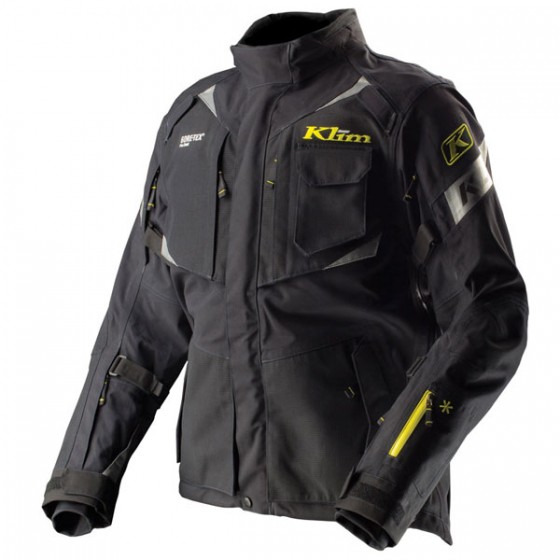
Smart and not too flashy..
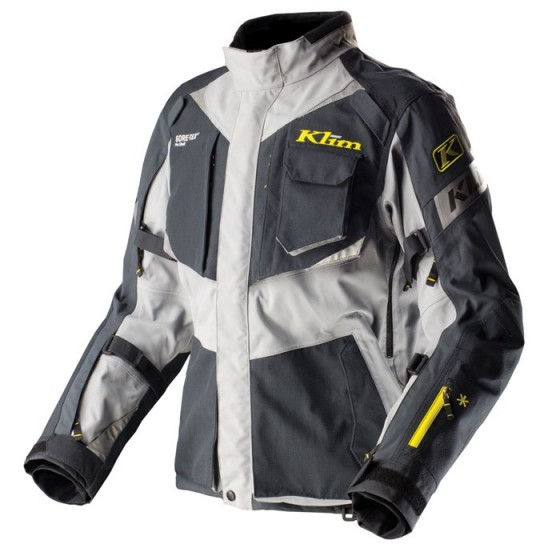
What’s not to like?
Putting the jacket on for the first time was a bit of an eye opener for me. While the Badlands Pro has the comparable weight of the BMW Rallye 3 it wears very differently. The Rallye 3 literally hangs it’s full weight off your shoulders but the weight of the Badlands Pro seems magically dispersed and almost unnoticeable. It also has a harness which once in place puts most of the weight on your hips and allows complete freedom of twisting side to side movement, with a big smile I realised the obvious benefits of this for riding tracks while standing. When not needed the belt neatly folds away into dedicated pockets or is completely removable. The shoulders and underarm material is made up with a slightly different material in the form of Stretch Gore Tex and a lighter Cordoba material again to help aid freedom of movement. Nice…
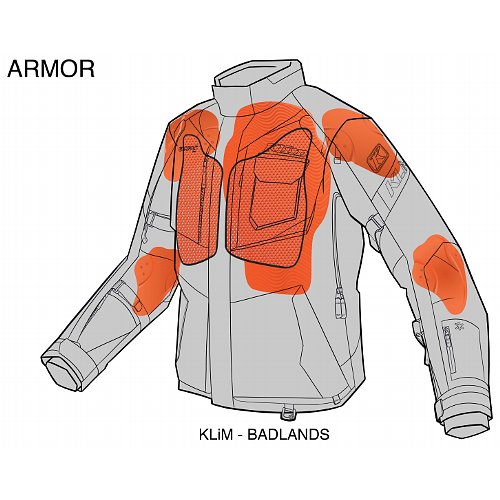
Armor light and comfortable without compromising protection..
For storage there are 4 dry pockets, another large storage pocket at the back, and more pockets on the inside, i.e. more than enough pockets. There is even a very hard to find hidden zipped pocket in the inside back to store a spare wallet. Perfect for hiding the bit of extra cash I have to carry in Spain for paying off the spot fines so efficiently pursued by the Guardia Civil tax collectors.
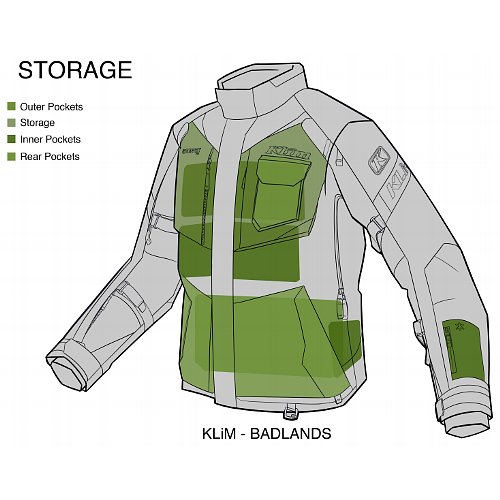
I’ve yet to use all the pocket space available..
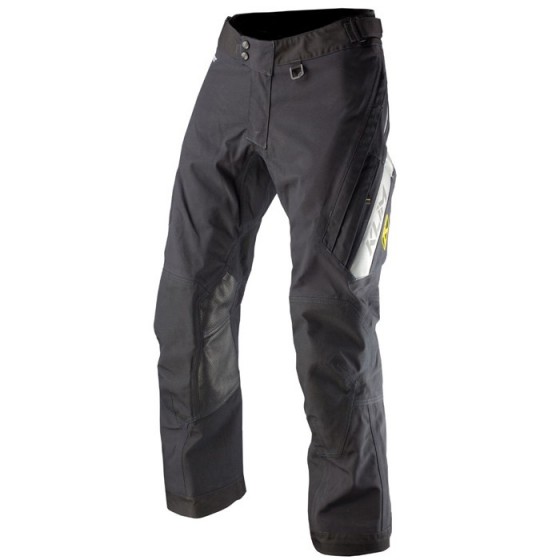
Pants are comfortable, functional and protective
Safe to say I jumped back on to the lads at Adventure-Spec.com and ordered up the matching pants. Again these were of comparable weight to the BMW rallye 3 pants and far heavier than my Rev’it Defender pants and made up of the same bomb proof material as the Badlands Jacket with the same armor type in the knees and hips. Unlike the Defender cinching adjusters the Klim one’s work far better, but due to their weight I still required the need of braces to keep the waist from joining the party around my ankles. What I really liked most however was the double venting with big, easy to operate while riding air scoops at the front and vent openings at the back so air flows nicely when on the move. The pants side pockets I was also impressed with as they are also easily accessible while on the bike with nothing likely to fall out due to their smart positioning. The pockets are on the thigh (cargo style) and running vertical when standing, horizontal when sitting so you can access your “pre-opened” power bars while cruising with the same setup for the venting zips front and back.
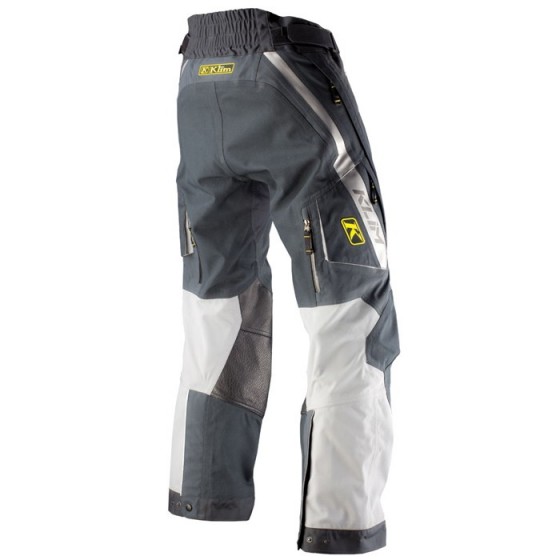
Vents on the front plus exhaust vents to the rear..
So, finally, what I have here is a protective, no fussing about all weather suit with an all day comfortable touring cut and strong off road features. If it rains in summer there is no need to stop and pull off my jacket, boots and pants to fit a waterproof liner which quite frankly is bloody ridiculous and completely impractical for me at least. If it gets too hot I just open up the vents and if too cold I put on my wooly knickers before I head out, if I then get too warm – I open the vents. My BMW Cooling Vest (Read Review) works very well in really hot weather with just the back and front vents open without risk of me becoming dehydrated too quickly. Sorted.
Suitably impressed the only thing left for me to do is a real world road test. I’ll keep this short. Got ferry from the Isle of Man to Belfast on the 3rd of Sept 2014 just after the Classic TT and rode down the Wild Atlantic Way to catch the ferry to France at Rosslare. Rode through France then both sides of the Pyrenees and on down to Almeria. I live/work in Spain for much of the year so I had plenty of time riding tracks and trails in Murcia in baking heat. Left Spain in mid November and I’m now back on the Isle of Man enjoying the type of winter only a tiny island in the middle of the northern Irish sea can face with grudging acceptance.
Donegal to Almeria Preview – a Road Test for Klim Badlands Pro
Badlands Pro in Winter Season
As a winter suit the Badlands Pro is perfectly wind and waterproof as long as you accept a heated under garment and/or winter base layers are an extra expense which I do. I’ve long since narrowed down my winter gear to wearing two thermal base layers and a tight fitting merino wool jumper for the coldest days, all of which fits snugly under the Badlands Pro Shell. So, as far as a northern winter is concerned I’m warm and dry.
Badlands Pro in Irish/UK Summer Season
For an Irish/UK summer I’m good to go in just a t-shirt with a base layer or light fleece as backup tucked into the back storage pocket adjusting the vents as I go to suit the ever changing weather. This also suited the Pyrenees in September. In Spain I have to admit things got a little hot as there is no getting away from the fact that the material on any gear in this 3 layer laminate shell group is heavy. So if you’re walking or sitting around under the southern sun in this gear you start feeling it’s weight and your world rapidly heats up, but while moving on the bike the venting works very, very well.
Badlands Pro in Over +35C
On days where temperatures got up above +35C I wore my BMW Cooling Vest under the Klim jacket which made life far more comfortable. Between the jackets ample venting allowing wind to swirl around inside the Klim jacket and around the BMW Cooling Vest I was as happy as a pig in shit.
Nit Picks
Another thing to be aware of is the outer chest pockets don’t seem to be 100% waterproof. However I strongly suspect the moisture entering the pockets is largely if not completely coming from my sweat as it evaporates out through the Gore Tex – as it’s supposed to. That said I had no water damage to items like money, smokes, electronics or passport etc stuffed into the pockets even on the wettest of days, just a bit of dampness.
Ideally I’d also like to have a little more adjustment options in the lower leg of the pants, however I still prefer the snap buttons Klim use above the velcro used for adjusting the legs bottoms in most of the competition. I also find the knee armour is a bit of a pain to adjust to it’s highest level. Again the problem stems from the tiny strips of velcro that seem a bit too weak for the task as the armour often falls down the pants internal slot. I’ve since fixed that by slapping a bit more velcro in there to keep the knee armour where I want it. Annoying, but certainly not a deal breaker by any means. I’d generally be a very picky person, and in 7 months of hard wearing use in varying weather conditions and temperatures from Northern Ireland to Southern Spain I honestly have very little in the negative to say about the Badlands Pro jacket or pants. But for me right now I’d go as far as saying it’s 95% perfect and a long way ahead of anything else I’ve used or seen.
Remember though, while the Badlands Pro Suit is a brilliant bit of all round kit it might not necessarily be right for you. This is just my independent review of all the touring suits I closely considered with my choice of the Badlands based entirely on my own personal experiences and requirements. I hope however my rambelings may help you make your own choice the right one that suits you best.
A closer look – Klim Badlands Pro Jacket & Pants Review…
A quick word on sizing
Jacket: I generally take a large, in the BMW Rallye 3 I take a size EU52 and for the Badlands Pro I went for the Medium size which fits like a glove. It does get a little tight when I bulk up for the cold buts it’s still fine. The American sizing runs a little large so the medium size was right for me.
Pants: I’m a 33 inch “variable” waist and 31 inch inseam so I went for the 34 Reg size which also fits fine. The cinching at the waist allows for a fair bit of flexibility for additional base layers/wooly knickers and a gut that tends to expand and contract depending on the frequency of my visits to the pub. Most likely however, like me you might need braces to keep ‘em up when walking about.
Value for money: the jacket/pants were far from cheap, but I definitely got what I’d payed for so in reality I see it as good value and a good investment. I’ve little doubt I’m going to get my monies worth due to the versatility of the design, the lifetime Gore Tex guarantee and the overall quality of all the components and fabrics used in the jacket – with the exception of the joyfully limited amount of velcro on the jacket. Suffice to say, I’m now a big fan of Klim….
 Where to buy: I got the Klim gear from www.Adventure-Spec.com who I reguarilly use as a supplier and would not hesitat to recommend them if buying from the UK, Ireland or the Continnent. They are always happy to answer any question on their products be it general or technical and once ordered I have always gotten my goodies within 3 days to the Isle of Man. Being bikers themselves it’s evident they are both proud and knowledgeable of the gear they supply and happy to help with any warranty or return issues. I’ve since realised Klim is the only jacket/pants manufacturer Adventure-Spec choose to sell which might tell you something.
Where to buy: I got the Klim gear from www.Adventure-Spec.com who I reguarilly use as a supplier and would not hesitat to recommend them if buying from the UK, Ireland or the Continnent. They are always happy to answer any question on their products be it general or technical and once ordered I have always gotten my goodies within 3 days to the Isle of Man. Being bikers themselves it’s evident they are both proud and knowledgeable of the gear they supply and happy to help with any warranty or return issues. I’ve since realised Klim is the only jacket/pants manufacturer Adventure-Spec choose to sell which might tell you something.
The other items I’ve bought from Adventure-Spec.com and highly recommend are the following:
Adventure-Spec Crashbars BMW F800GS Adventure »
Adventure-Spec Bashplate BMW F800GS Adventure »
(Both of which are also fitted to my standard F800GS – Note: different part number)
Wolfman Expedition Dry Panniers / Saddle Bags »
Adventure Spec Tool Tube »
Sidi Adventure Gore Boots »
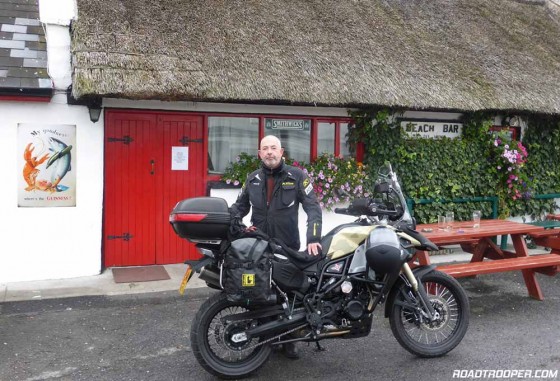
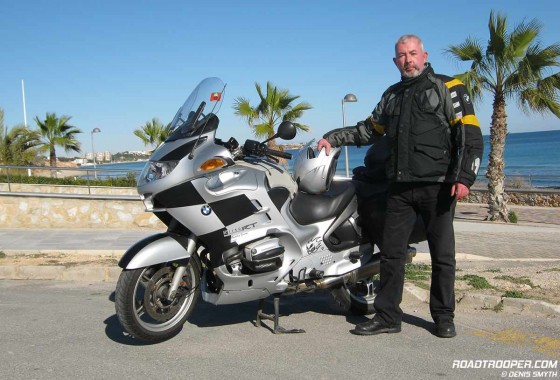

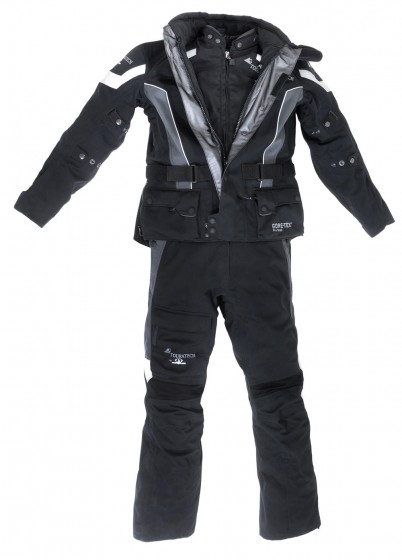
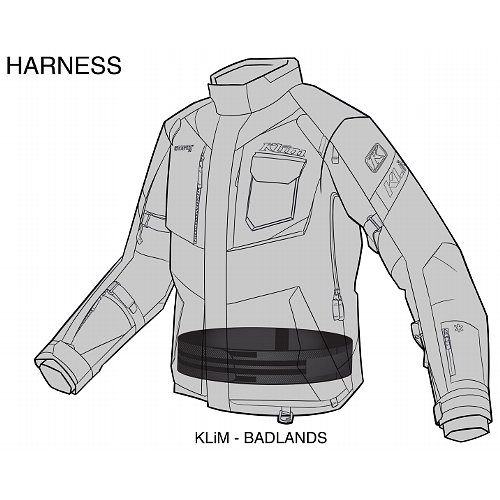
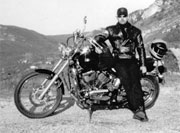







I could give you a very positive review of the Companero without being heavily sponsored. I’m also not ridiculously rich.
As an owner of the suit who, as opposed to you, used it in real world conditions (and by that I mean *all* kind of conditions, from 0C to 40C and everything in between, dry or wet) I have to say that I don’t agree with your evaluation of how the suit would behave in various non-extreme temperatures or summer rain.
If it’s 22C in Italy (or Romania) and pissing rain, I’ll just open the armpit vents of the overshell.
If it’s autumn and too cold for just the mesh, I’ll open the overshell in front and together with the armpit vents this will make for a nice flow. I can also detach the 2 chest zips that connect the shell to the summer jacket, and the flow will be bigger. And I can do that without compromising safety, because the summer jacket stays closed and tight.
Hi Dragos,
Thanks for writing in with your own thoughts of the suit. While I only tried the suit on in the Touratech shop in Alicante I certainly never actually got to use it out on the road so I admit my opinion is severly limited. What put me off, or what worried me was all the layering (inner/outer layers) and my own experience with many suits with a detachable layering system which seems the most common. In winter I’m still fine with that but got totally fed up with this system in hot, humid and sometimes very wet conditions in places like the Pyrenees which led my opinion and arguably an overly harsh opinion of the Companero. At the time I’d also not found any reviews online of the Companero other than ones that were obviously sponsored and which failed to sell me the concept or values of the suit.
Without a doubt there is no better way of gaining a proper opinion of a piece of equipment than actually owning it and using it oneself. This review as a whole is as much about the process I went through in deciding which suit to invest in and the process of elimination to find the one best suited to my own personal requirements. The idea behind it was to hopefully help others looking for new riding gear decide on investing in something that actually matches their needs rather than what the marketing engines tell us what we should buy. With all the various options now available by countless brands it’s not such an easy thing, or at least far more complicated than it was 15 years ago when there were only a handful of brands making anything at all for the touring/adv-touring segment. I’ll be the first to admit that I’ve regretfully bought gear based on brand identity or style only to quickly find on the road that what I bought may have been what I wanted, but not what I actually needed leading to money wasted.
If you have the time and would like to write a full review and your own experiences with the Companero I’d be more than happy to put it up here on this website. I’ll but it on the front page for a period and connect it to my own review as an argument against my own opinion. While I still don’t think the design of the suit is for me it’s also true that it may be exactly what someone else might need. Every biker is different whith different requirements based on siding style, location, types of roads, weather etc etc, the list is endless. Understanding all this is essential when choosing a touring suit to match everyones individual requirements. I decided on the Klim for very specific and personal reasons, and after 5 big trips I’m very happy in my decision, it’s not perfect but it was a better fit for me against very tough market competition.
I’ve no doubt many of this sites readers and any considering the Companero and looking for an honest, independent opinion would find a review by an actual owner of the Companero absolutely invaluable, so please do write back and I will post it to help our brothers and sisters to make an informative decision based on the real world use of such gear by those of us suffering from terminal wanderlust..
Thanks again,
Denis
Denis,…. I can only confirm your comments and reasonings re the Badlands Pro suit. I bought mine after the usual agonising earlier this year and it has served me well on a couple of wet trips to Scotland and a hot trip to northern Spain ( upto 36 C ) It is waterproof and when correctly layered up is warm, The Goretex pro is excellent and condensation is not retained inside.. In Spain the venting worked well with a good technical T shirt ,Obviously the quicker you get the stuff off when you stop the better . Finally the inner waistband is a genius addition ,stabilising the jacket and distrubuting the weight, and yes the armour is comfortable..
Thanks for the write ups on the WAW Me and my KTM aim to make a start on it in early September..
David
Hi David, I hope you will enjoy the WAW as much as I do and the weather will be kind for you in Sept.
I’ll be doing the WAW again in early Sept myself starting off in Baltimore on the 2nd then making my way north so if you see me be sure to say hello and we’ll have a cuppa..
Denis
Hi Denis.. <our initial thoughts are to be at the Northern end of the WAW around the 7th sepr and to follow the route to probably finish in the Sligo 'area about 6 days later leaving the rest for next year.. We will watch the weather and if the south is looking more settled we will consider starting there .. Anyway it would be good to meet up if poss and will contact nearer the time with our plans.. Time wise we are pretty flexible as we (2 old Guys , GSA 1200 LC and KTM 1290 super Adv ) are both retired….Are you doing the full route?
Best wishes…… David
I won’t be doing the full route this time, I’ll be staying in north Sligo on the 8th then heading south again staying in Clifden on the 8th then either Ballyvaughn (a great little town just south of Galway) or home to Killarney again on the 9th, I’ll finalise the route tomorrow hopefully.
Drop me an email at denis.smyth@roadtrooper.com when you know your schedual and we’ll see if can meet up for a pint
D
Hi Denis
Thanks very much for writing this. I am just in the process of trying to decide on all this stuff after a return to biking following 10 years away from it, so a lot has changed and your article has brought me ‘up to speed’ on the latest concepts.
I just have a couple of questions (you may not be able to answer them but no harm in asking!)…
First here’s my intended use for the kit I buy (riding Tiger XC 800 btw)….
Mostly UK tarmac, with some UK ‘light’ off-road and the odd trip to European tarmac, but EU will be an exception rather than a rule.
I feel the heat very easily and usually have more trouble staying cool in the summer than I do keeping warm in the winter, even in the UK where I mostly ride (mild and wet weather for the most part).
I will be doing some winter riding but only a little. I may get a heated vest for that so the jacket/jeans combo doesn’t need to be that warm as long as it’s an absolutely waterproof outer shell.
Now my questions…
- I have been looking at the Rukka Armaxis jacket (successor to the Armas you mention). It has supposedly been slighty improved for ventilation. However, I’ve heard it’s still a warm jacket compared to many. It sounds like the Badlands may offer a lighter, cooler alternative but with the same protection. Is that right? Does it have the same level of protection as the Rukka in case of an accident, do you know (especially abrasion)???? Is the ‘shell’ as tough? This is a priority for me.
- I understand the Rukka has an inner lining (removable), which the Badlands does not have). I’m just wondering how the Rukka with the lining removed varies (weight/warmth wise) from the Badlands. On paper, once the Rukka inner lining is removed they should both just be a (similar?) ‘layered shell’.
- I see the Badlands is now being described in the shops as ‘old version’ jacket/jeans. Have you had any hands-on experience with any Klims successor model to the Badlands since writing your article?
Sorry for so many questions but I hope you won’t mind me asking anyway.
Thanks again for sharing your experiences in choosing the right kit for you. It does sound as though the Badlands is very nice clothing (but so is the Rukka). Decisions, decisions.
I think it’ll definitaley be one of those two for me.
Best wishes.
Neal
Hi Neal,
First of all welcome back to motorbikes
If you’re worried about being too hot rather than too cold then you will probably find the Rukka way too warm in summer even without the lining. This gear was designed by Finns with the very northern European market in mind.The Klim Badlands has far more venting to keep you cool, you then just layer up to suit yourself in winter etc. So let’s just take the Rukka off the list for now.
The Badlands (new and old) are freaking bullet proof, but you should fully understand what it is. For the average or leasure rider these jackets can easily be considered overkill. The Badlands will certainly outlive your Tiger with normal use, and possibly you even if you live to a ripe old age. The Badlands for example really is designed for heavy duty wear in all weathers on all terrain, day in and day out for a very long time. When you buy into this level of gear it really is for a round the world, overland, hard trail expedition.
But, as with all things you have to make compromises. This gear is heavy, for example the weight and the thickness of the heavy duty material on the Badlands makes it not nearly as comfortable as say the Rev’it Defender suit so you need to take this into account. The newer Klim Badlands has even more venting and is a little lighter than my version, but even with all that venting you can’t ignore the fact that it is a heavy duty, hard wearing product with a full Gore-Tex shell so it’s going to be very warm in summer no matter how many vents they add.
All all-in-one Gore-tex shell suits will, by nature be warmer than their removable layer counterparts. So be sure you can accept this before you buy, the Badlands heavy duty cordoba material adds extra weight into the mix too, so I’d say this might be something you may consider for two reasons. Firstly, as you mentioned, you feel the heat very easily, as do I. I find the Badlands very hot once the sun comes out and temperatures climb above 18C. It’s fine once you’re on the bike moving fast and the air is flowing, but you won’t be walking around interesting villages in this gear for long. On hot days I find myself opting to wear lighter gear unless I know I’m going trail riding.
I bought this gear for it’s ability to ride anywhere in any weather and because I clock up far more milage than the average leasure rider. And I’m always on a bike, I don’t even have a car licence. I also spend a lot of time during the summer as a tour guide in France, Spain, Alps, Pyrenees, inc some fairly hairy trails etc which makes the use of a heavy adv shell suit a better choice over the layering system suits. So while I’m not going to ride around the planet there is still a fair chance I’ll wear out the suit within the next 8 years or so as I’ll be spending so much time outdoors in this gear it’s likely it’s the UV rays that will eventually do the gear in as much as wear and tear. At the end of the day I choose this suit as a tool to do a very specific job.
I don’t know how much mileage you intend to do per year, but unless you intend to effectively live in the Badlands suit I’d have to wonder if you’ll get your money’s worth out of it, especially if you end up buying a lighter, cooler suit for summer which I suspect is likely to happen.
You also mentioned abrasion resistance and protection compared to the Rukka. I’d not worry about that simply because you are living in the UK where roadside furniture, cars, lamp posts, trees, traffic lights, walls, kerbs etc is statistically far, far far more likely to stop you long before the abrasion resistance of sliding down a road will. If, God forbid you were to have an accident I’m afraid it’s blunt force trauma that’s far more likely to do the damage. When it comes to abrasion resistance the leather one piece is still the best kit, but unless you’re doing high speed track days then you only really need a good level (Level 2) of abrasion resistance which most mid range textile suits (e.g. Rev’it Defender) provide.
When it comes to the likes of the Rukka or Klim suits I’d not like to think what speed you’d have to achieve in an off where you’d likely damage those suits let alone destroy them. And not to forget the difficult fact to face that it’s likely to be a wall or tree that will inevitably stop forward momentum. So, while the Rukka/Klim gear uses top of the range armour as standard, the lower standard armour that comes with mid range gear can be replaced with the higher spec armour very cheaply. I think the Rev’it gear takes D30 Level 1,2 or 3 armour.
Good to note though, the latest version of the Badlands not only has more venting but it also has superfabric on the elbows, forearms, back, knees etc for even more abrasive resistance. So if you were to decide on the Badlands the latest version is the one I’d be going for because of the venting. I’m not sold on the superfabric however as it has a downside. It’s an abrasive agent itself, so if any of it rubs against your bikes shiney paint job (e.g. knees on tank) it will destroy it. Again, there are pros, cons and compromises to everything.
All things considered are you absolutely certain you need a heavy duty and highly technical shell suit? If it were me in your position I’d be looking something like the Rev’it Defender which is far cooler and much much lighter in summer. It’s also far easier to live with if you want to do any walking about off the bike, sightseeing and the like. The outer cordura fabric is shower proof and does not become too heavy after a serious soaking. And in hot weather the waterproof layer can be removed unlike the Badlands where it’s permanent. The layered suits are still the most popular for good reason and not just because they are cheaper to manufacture.
With the money I’d save on the defender or similar suit itself I’d use the savings to buy some extra safety gear to seriously protect me against a bikers most likely enemy – blunt force trauma. The fact is that even with the Badlands and the like the armour used within the garment is not going to save you from injury if you hit an immovable object at speed be it a road or a wall. Another problem I’ve found with all suits is with the pants in that the knee armour is unlikely to be in the right place when you really need it.
Since writing this article I’ve given up with the knee armour inserts alltogeather in both my Defender and Badlands pants and now use stand alone knee pads (https://www.planet-knox.com/product/defender-mtb-knee-pads/). And I am far from the only one now making this choice. The armour in modern suits is far superior to anything that was about 10 years ago, but this format “placed within a garment” has its limitations no matter what it is made of and there is no getting around it. And in my view it’s questionable at best in pants where armour is too free to move about and not necessarily being in the right place when you need it.
That’s why MX riders don’t even bother with in garment armour and opt for stand alone, fitted armour. This type if armour is now becoming far more popular (mostly due to new materials and levels of comfort) for road riders. It’s a direction I’m now leaning towards as “safety wise” it’s becoming the best option for both off road and urban riding where blunt force injuries are the norm rather than road rash. The older I get the more time it will likely take me to recover from an injury, and older injuries now seem to be coming back to haunt me every winter so I’m always looking at the newest and best ways to protect myself on our ever busier and built up roads.
If you are particularly safety conscious have a look at the following just to consider the options and cost
https://www.planet-knox.com/product/urbane-shirt-for-under-motorcycle-jackets/
https://www.planet-knox.com/product/venture-shirt-motorbike-gear/
https://www.planet-knox.com/product/trooper-mtb-shorts/
The benefit of armour directly attached to the body, besides the good level of impact and abrasion protection is that you can turn even a mid range or mesh touring gear into something very protective in the event of a spill. I don’t say a great level of impact protection because no form of armour plates/cups etc can shield the shock your internal organs receive during a blunt force impact to the torso. To date the best form of armour protection I believe is the inflatable vest, the latest one being this which will protect internally as well as externally – http://www.sportsbikeshop.co.uk/motorcycle_parts/content_prod/227916
So what I’m suggesting, if safety is a strong concern, as a possible option is to separate the armour / protection issue and get that sorted. Then choose the weather protection in the form of the most comfortable riding suit that has a good (not necessarily the best because attached under armour will also provide this) level of abrasion resistance and durability. The Rev’it Defender suit is very comfortable and versatile, it’s got very good abrasion resistant (superfabric) and mesh panels as well as big vents for summer riding. The armour is adequate in places and sucks in others needing upgrading without question, made bullet proof with the use of Knox/D30 gear made affordable by the lower cost of the suit. The only downside is that waterproof layer is separate and not built in as in a gore-tex shell which can make it a bit of hassle in hot showery weather. The upside is that it’s far lighter in summer than any gore-tex shell suit.
Food for thought, hope I’ve not given you a new headache lol..
Denis
I’m going to buy a Badlands gray suit (old model) but I found only grey jaket and black pants . I have not the possibility to see or try them. Do you think it is a good idea, or better with grey Overland pants. I’m not doing hard enduro, but I use unpaved road on the mountings .
(Anyway, I balance between Klim and BMW R3 Suit).
Thank you .
Hi Ovidiu
Firstly both suits Badlands/BMWR3 are bulletproof, the big difference between the two is how they protect you from the rain, the Klim gear having an outer GoreTex layer while the R3 has an inner removable layer. Both are expensive, but you will get your money’s worth as these suits last for years of hard use.
I don’t see a problem with matching a grey jacket with black pants as long as you will be happy with the color difference for the lifetime of the suit, anything between 5 and 10 years, maybe longer depending on use and care.
While the Badlands/R3 are top of the range, the Overland is classed as a mid ranged suit and there is a quality difference in the materials. However I don’t see any real problem in matching Badlands jacket with the Overland pants even if you intended to ride the Dakar Rallye. Both the Badlands & Overland pants wear loose (like most adv/touring pants) so I would recommend extra knee protection either way given the higher likelihood of an off while riding any off tarmac route. I think the key difference of the Badlands jacket & Overland pants is that the jacket might outlive the pants as the jacket is more rugged. But in my experience over the years my jackets receive more wear and tear than the pants, so the BL jacket and overland pants may be a good match. I’ve not seen or worn the Overland gear however so I can’t be sure on this, my opinion on the Overland gear is only based on others experience and reviews I’ve read.
If you’re ok with that then fire away, you would not be alone in matching the BL jacket with the Overland pants, others do. One word of advice on this if you can not try the gear on before you buy, talk to the supplier first before you buy to be sure they accept returns/exchange in case the fit is not correct. Kilm gear is made for the American market, some people in Europe don’t fit well in the Klim gear when it comes the chest, arm, leg length. Your supplier should help you on this so give them a call. The last thing you want is an indestructible suit that does not fit properly as it will be uncomfortable, annoying and can distract you from your ride as well as not function properly.
Hope this helps,
Denis
Hi, Denis!
I am determined to order BL suit, in grey/black combination. Unfortunately, the jaket is no more available, so I buy the new model, with old pants, being at 50%.
From the comments, I only fear about too short collar hight, but I hope to be ok.
I have the possibility to return the gear if it does not fit .
Thank you for your advise.
Ovidiu